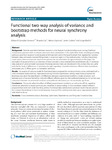Mostrar o rexistro simple do ítem
Functional two-way analysis of variance and bootstrap methods for neural synchrony analysis
| dc.contributor.author | González Montoro, Aldana María | |
| dc.contributor.author | Cao, Ricardo | |
| dc.contributor.author | Espinosa, Nelson | |
| dc.contributor.author | Cudeiro, Javier | |
| dc.contributor.author | Mariño Alfonso, Xurxo | |
| dc.date.accessioned | 2015-04-23T11:00:27Z | |
| dc.date.available | 2015-04-23T11:00:27Z | |
| dc.date.issued | 2014-08-12 | |
| dc.identifier.citation | González Montoro AM, Cao R, Espinosa N, Cudeiro J, Mariño J. Functional two-way analysis of variance and bootstrap methods for neural synchrony analysis. BMC Neurosci. 2014;15:96 | es_ES |
| dc.identifier.uri | http://hdl.handle.net/2183/14446 | |
| dc.description.abstract | [Abstract] Background: Pairwise association between neurons is a key feature in understanding neural coding. Statistical neuroscience provides tools to estimate and assess these associations. In the mammalian brain, activating ascending pathways arise from neuronal nuclei located at the brainstem and at the basal forebrain that regulate the transition between sleep and awake neuronal firing modes in extensive regions of the cerebral cortex, including the primary visual cortex, where neurons are known to be selective for the orientation of a given stimulus. In this paper, the estimation of neural synchrony as a function of time is studied in data obtained from anesthetized cats. A functional data analysis of variance model is proposed. Bootstrap statistical tests are introduced in this context; they are useful tools for the study of differences in synchrony strength regarding 1) transition between different states (anesthesia and awake), and 2) affinity given by orientation selectivity. Results: An analysis of variance model for functional data is proposed for neural synchrony curves, estimated with a cross-correlation based method. Dependence arising from the experimental setting needs to be accounted for. Bootstrap tests allow the identification of differences between experimental conditions (modes of activity) and between pairs of neurons formed by cells with different affinities given by their preferred orientations. In our test case, interactions between experimental conditions and preferred orientations are not statistically significant. Conclusions: The results reflect the effect of different experimental conditions, as well as the affinity regarding orientation selectivity in neural synchrony and, therefore, in neural coding. A cross-correlation based method is proposed that works well under low firing activity. Functional data statistical tools produce results that are useful in this context. Dependence is shown to be necessary to account for, and bootstrap tests are an appropriate method with which to do so. | es_ES |
| dc.description.sponsorship | This work was supported by grant MTM2011-22392 from the Spanish Ministry of Economy and Competitiveness. AMGM was supported by a “Formación de Personal Investigador” (FPI) grant (BES-2009-017772) from the Spanish Ministry of Economy and Competitiveness. AMGM, NE and JM were supported by Xunta de Galicia (INCITE09 137 272 PR). The authors would like to thank Professor Juan Cuesta-Albertos for his useful comments during the early stage of this research. | |
| dc.description.sponsorship | info:eu-repo/grantAgreement/MICINN/Programa Nacional de Investigación Fundamental/MTM2011-22392/ES/INFERENCIA ESTADISTICA PARA DATOS COMPLEJOS Y DE ALTA DIMENSION: APLICACIONES EN ANALISIS TERMICO, FIABILIDAD NAVAL, GENOMICA, MALHERBOLOGIA, NEUROCIENCIA Y ONCOLOGIA | |
| dc.description.sponsorship | info:eu-repo/grantAgreement/MICINN/Programa Estatal de Promoción del Talento y su Empleabilidad/BES-2009-017772/ES/ | |
| dc.description.sponsorship | Xunta de Galicia; INCITE09 137 272 PR | |
| dc.language.iso | eng | es_ES |
| dc.publisher | BioMed Central | es_ES |
| dc.relation.uri | http://dx.doi.org/10.1186/1471-2202-15-96 | es_ES |
| dc.rights | Creative Commons Attribution 2.0 (CC-BY 2.0) | |
| dc.rights.uri | http://creativecommons.org/licenses/by/2.0/ | |
| dc.subject | Cross-correlation analysis | es_ES |
| dc.subject | Bootstrap | es_ES |
| dc.subject | Spike-trains | es_ES |
| dc.subject | Dependence | es_ES |
| dc.subject | Low firing-rate | es_ES |
| dc.subject | Functional data | es_ES |
| dc.title | Functional two-way analysis of variance and bootstrap methods for neural synchrony analysis | es_ES |
| dc.type | info:eu-repo/semantics/article | es_ES |
| dc.rights.access | info:eu-repo/semantics/openAccess | es_ES |
Ficheiros no ítem
Este ítem aparece na(s) seguinte(s) colección(s)
-
GI-NEURO - Artigos [165]






